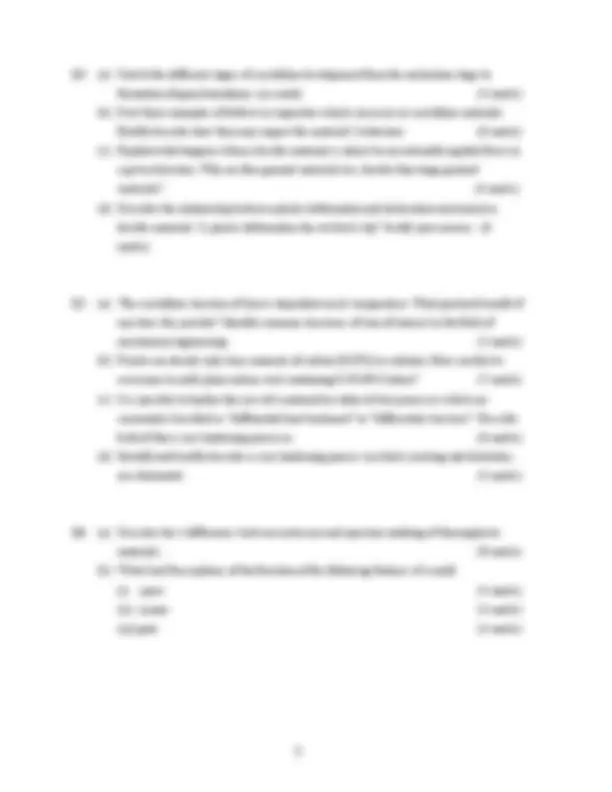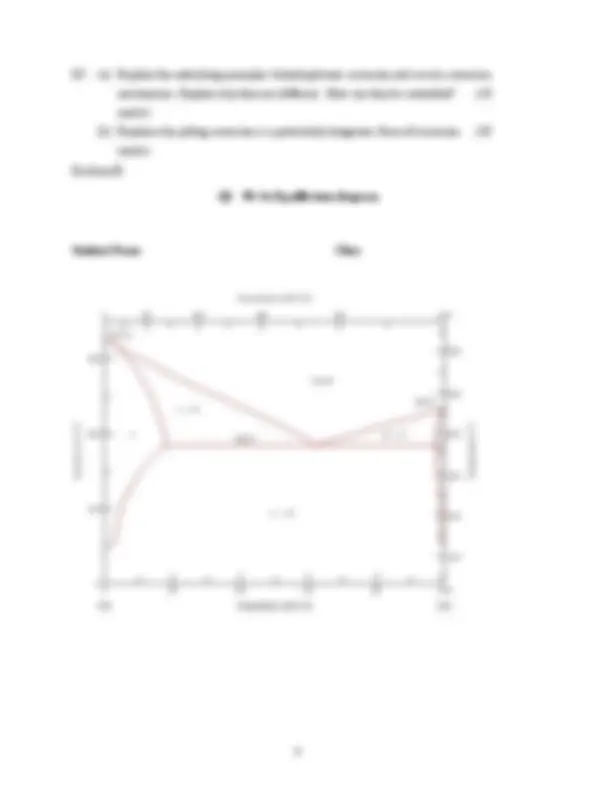




Study with the several resources on Docsity

Earn points by helping other students or get them with a premium plan


Prepare for your exams
Study with the several resources on Docsity

Earn points to download
Earn points by helping other students or get them with a premium plan
Community
Ask the community for help and clear up your study doubts
Discover the best universities in your country according to Docsity users
Free resources
Download our free guides on studying techniques, anxiety management strategies, and thesis advice from Docsity tutors
A past exam from the higher certificate in engineering program at cork institute of technology, focusing on manufacturing technology. The exam includes questions related to milling processes, metal alloys, composite materials, crystalline development, and material defects. Students are required to answer five questions, each carrying equal marks. The document also includes a pb sn equilibrium diagram.
Typology: Exams
1 / 4

This page cannot be seen from the preview
Don't miss anything!



Instructions Answer FIVE questions. All questions carry equal marks.
Question 1 must be answered.
Use separate answer books for each Section.
If you attempt Q2, please return the equilibrium diagram sheet with your answer book.
Use annotated diagrams where applicable.
Examiners: Mr. M. Daly Mr. R. Kennedy Dr. G. Kelly Dr. P. Delassus Mr. J. Connolly
Q1.(a) You are required to mill a slot 10mm wide and 100mm long, from one end of a 19mm square piece of mild steel, using a vertical milling machine. List the sequence of steps in milling the slot on centre 5mm deep which should also include alignment of vice etc. (12 marks) (b) If the cutting speed for mild steel is 27m/min., calculate the speed in revolutions per minute and the feed rate in mm per minute if the cut per tooth is 0.08mm. Select your own cutter for the project. (8 marks)
Q2. (a) A lead tin alloy of composition 30% Sn 70% Pb is slowly heated from a temperature of 150 °C. (i) At what temperature does the first liquid phase form? (2 marks) (ii) What is the composition of this liquid phase? (3 marks) (iii) At what temperature does the complete melting of the alloy occur? (3 marks) (iv) What is the composition of the last solid remaining prior to complete melting? (3 marks) (b) For a 40 %Sn 60 %Pb alloy at 150°C , find (i) the phases present: (3 marks) (ii) the compositions of the phases: (3 marks) (iii) the mass fractions of each of the phases. (3 marks)
(Note Please return the equilibrium diagram with you answer book)
Q3. (a) Provide a simple definition of a composite material and give to examples of composite materials. Are metallic alloys composite materials? Justify your answer. (4 marks) (b) Sketch the composite materials classification tree indicating broad classification of composite materials and their reinforcement. (4 marks) (c) Whiskers and fibres are two types of fibrous reinforcement used in composite materials. Describe the essential differences between carbon whisker fibres and carbon fibres in terms of their respective size, strength, and use. (4 marks) (d) Reinforced concrete is a composite material. Can it be considered as an example of a fibre reinforced composite or a particle reinforced composite? Justify your answer. (4 marks) (e) An epoxy matrix material (E (^) m = 3.0 GPa) is to be reinforced with glass fibres whose elastic modulus Ef is 80GPa. Estimate the volume fraction of the fibres necessary to give an elastic modulus for the composite in the longitudinal direction (Ecl ) of 49.2 GPa. (4 marks)
Q7. (a) Explain the underlying principles behind galvanic corrosion and crevice corrosion mechanisms. Explain why they are different. How can they be controlled? ( marks) (b) Explain why pitting corrosion is a particularly dangerous form of corrosion. ( marks)
Q2 Pb Sn Equilibrium diagram
Student Name Class